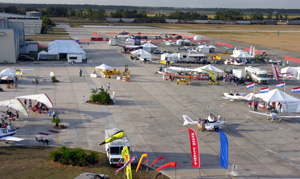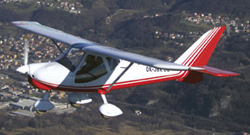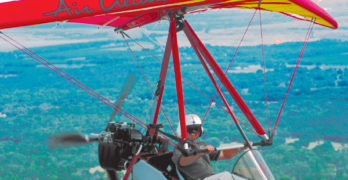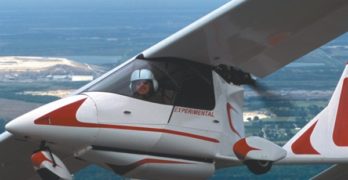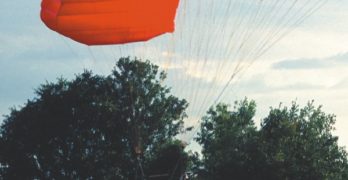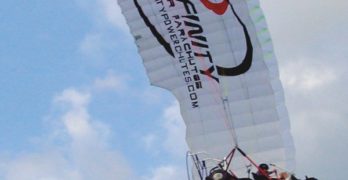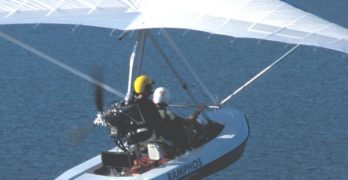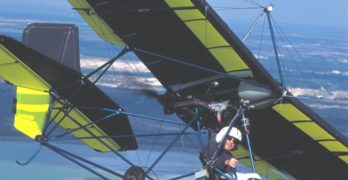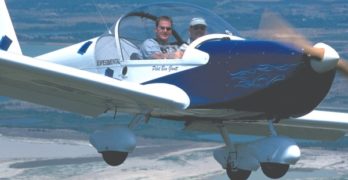The Wrightness of one man’s dream
On December 17, 2003, Tom Ivicevich’s Wright Flyer won’t represent the only attempt to recreate the brothers’ famous accomplishment. Nor will he be the only Wright pilot flying cross-country to arrive at the sand dune shrine in Kitty Hawk, North Carolina. But Ivicevich will do it all without major sponsorships. And he intends to fly coast to coast in his enhanced version of the original Wright Flyer.
This is one man’s dream, and he is well underway to reaching his goal.
Creating Interest
In January this year, Ivicevich’s 5¼8-scale Flyer flew while being towed by a 1930 Model A pickup truck at Redding Municipal Airport in California. The 190-pound aircraft took readily to the air at 25 mph.
In February, Ivicevich announced, “I am now organizing the start of construction for the full-size Flyer.” Next year, he plans to launch from Torrance, California, and make his way across the country.
Search Results for : Flight Design
Not finding exactly what you expected? Try our advanced search option.
Select a manufacturer to go straight to all our content about that manufacturer.
Select an aircraft model to go straight to all our content about that model.
Sebring II Is Proving a Big Success
The second running of Sebring is a success by any measure. Days one and two enjoyed warm weather with good conditions for a large number of demo fllights. One fascinating development was the arrival of some top Cessna officials who evidently came to check out the LSA scene although their presence was relatively low key (however, it’s hard to hide a bizjet on the ramp among a flock of LSA). No one was saying what might transpire. Sport Aircraft of all varieties were present including most fixed wings and several trikes and powered parachutes. Sebring visitors also saw the arrival of the first flying version of the Advanced Aero Inverted V design. According to lead engineer Chris Gagliano, “Our single seat prototype has already completed six hours of flight time after its first flight on December 30, 2005.” Chris, his father, and their team are at work on the two seater and their work has progressed logically through computer models and physical models.
SportRider Wins SLSA Approval
After a short lull in new approvals, the first to announce winning FAA’s blessing following AirVenture Oshkosh 2005 is AveoUSA’s SportRider. Designed by Jaro Dostal, the same man who created the comfortable SkyBoy, SportRider is built by Gryf Air of the Czech Republic and handled by FlyItalia. Sport Rider is sold in America by Texas-based AveoUSA. Once folks returned home from EAA’s big show this year, I got several emails from pilots asking about this handsome aircraft with its flowing lines and 46-inch-wide cockpit. You can see my early report in the August 2005 Kitplanes magazine and I hope to do a pilot report this fall, perhaps on one of the EAA Sport Pilot Tours where you can also go for a demo flight.
Air Creation Buggy/Kiss
For many years, I’ve been critical of trike handling. While I try never to forecast the future, I’ve gone out on a limb and predicted that rigid-wings will eventually become commonplace on trikes (though I don’t also predict delta wings will disappear).
Going Rigid?
Rigid-wings look a lot like modern hang gliders and trike wings in many ways, but they have control surfaces. Because these surfaces are deployed via weight-shift movements they neatly combine the benefits of 3-axis ultralights – lower control forces and good control authority – with the elegant simplicity of weight-shift. Rigid-wings can carry good weight and are somewhat faster than delta wings (called “flex wings” by hang glider pilots), and they also handle more easily. I think this makes them a nearly inevitable development.
While I still believe rigid-wings are coming to trikes, it may take longer than I thought because the trike industry may finally be rising to the challenge.
All the Plane You May Want
Over the years, Titan Aircraft has made their Tornado a familiar aircraft seen at flight parks and airports around the nation. Since it was introduced in ’91, the sleek, efficient plane has evolved into a variety of models.
This month we examine the fine work of Roger Bacon who created a lovely red-and-white Tornado II 912, powered by the 100-hp Rotax 912S 4-stroke powerplant expected to be commonplace on light-sport aircraft. Bacon’s airplane is licensed in the Amateur-built category but its facts and figures suggest it could be flown with FAA’s proposed Sport Pilot certificate (until FAA’s new rule is introduced, a private pilot’s certificate or better is required).
Usually I prefer to fly a factory airplane to make sure it correctly represents what a buyer might receive. However, Bacon’s model is so well done, Titan Aircraft encouraged a test flight. Thanks to Bacon for his willingness to let me take his pride and joy aloft.
Hybrid Powered Chute
As focus sharpens on FAA’s proposed Light-Sport Aircraft regulation, the first aircraft segment to complete an ASTM airworthiness consensus standard is powered parachutes. While these aircraft are simpler, which helped speed the process, participating manufacturers got together well and hammered out their certification rules efficiently.
Summit Powered Parachutes of Canada hasn’t yet chosen to enter the Light-Sport Aircraft arena. They aren’t worried, just wary of new regulations. In fact, the company started work under England’s BCAR S regulation. Just recently, Summit was working to qualify for German DHV certification. They see no great challenge passing the proposed U.S. powered parachute standards, as currently defined.
Fortunately, the proposed Light-Sport Aircraft is not the only destination in sport aviation. It may be part of the spectrum of aviation regulations.
We’re seeing more new designs tuned to Part 103. And the Amateur-Built 51% rule will still allow many 2-seat ultralights to be built and flown as they are today.
Infinity Power Parachutes
On a warm summer evening, a large field of 3-foot-tall oats sways gently in the breeze. In this pastoral setting a runway is cut down the middle. The farmer who owns this field has a light aircraft he flies from his country property, and he’s kind enough to allow Tim Norling, a local powered parachute pilot, to use it, too. Norling operates Let’s Fly, an Infinity powered parachute dealer 20 miles north of Minneapolis, Minnesota.
By the time Norling gets his Infinity powered parachute set up, the winds have quieted down, as we hoped they might. It is a beautiful evening for flying in Minnesota, and I am ready for a flight.
Some pilots say, “Oh, those powered parachutes are too vulnerable. You can only fly them in gentle winds.” Yeah, so? Is it really imperative to fly in strong winds? Is being restricted to mild conditions a bad thing?
Powered parachutes tend only to be flown when it’s pleasant to do so.
Italy’s Ramphos Flying Boat
Making a Splash
Last year as the flying season began, an unusual flying boat appeared at airshows. The machine was called Ramphos (pronounced RAM-fohss) and it featured a form of ducted prop surrounding a pair of counter-rotating blades. While these two components commanded a lot of attention, they were de-emphasized when the 2004 season arrived.
In 2003, the presentation was market-savvy. By showing a somewhat radical version of the familiar flying boat design – we’ve seen a few of these configurations over the years – the Ramphos attracted attention in a crowded marketplace. When you’re new (to the American public), you need some way to stand out from the crowd.
However, the downside of new, potentially radical ideas is that people – like me – tend to wait until the new concepts prove themselves. So I didn’t fly the Ramphos in 2003. That changed for 2004.
Modern Machine
For the 2004 flying season, the emphasis had been taken off the counter-rotating props, though it was still displayed and remains an option.
Simple Sprint Pleasures
Excelling at “Just For Fun”
Going back to our roots and the dandy little ultralights that have given in-flight satisfaction to so many, we’re going to take a look at one of those aircraft, Quicksilver’s MX Sprint.
Some veteran pilots call the MX Sprint “humble,” but it is one of those “original” ultralight aircraft that simply won’t go away, and it shouldn’t. Why? Because the Sprint still offers a joyful flying experience that redefines boring holes in the sky. You pilot a Sprint in relative ease and at remarkable low cost, and once price enters the discussion, many ultralights show their value clearly.
Many in light-sport aviation are realizing that aircraft certified Experimental Light-Sport Aircraft (ELSA) and Special Light-Sport Aircraft (SLSAs), even when approved under a simplified, industry-created, ASTM-guided program, will be rather expensive aircraft. Some sleek fiberglass creations are reaching toward the six-figure mark – an unbelievable development given that ultralights have historically traded in a range of $8,000 to $35,000, the latter being a superbly equipped, Rotax 912-powered machine.
Star in Your Sky
The expression “seeing stars” is a good thing, if it means flying a delightful aircraft on a lovely day. After sampling the Sportstar in ’02 (see “Sportstar Pilot’s Report”, December ’02 Ultralight Flying!), I looked forward to a flight in its predecessor, the EV-97 Eurostar. You could say I had stars in my eyes. A blue Florida sky was dappled with miniature cumulus clouds, winds were mild, and the fuel tanks were full in a pretty blue-and-white Eurostar. I was ready.
On a beautiful Saturday, April 17, I flew the Evektor Eurostar with Nick Motlagh (pronounced “MOTE log”) – a sharp young aviator about to embark on a career in the air. He has been accepted to compete for fighter jet training in the Air Force after graduating from Embry Riddle Aeronautical University in Daytona Beach, Florida.
Motlagh had flown the Eurostar (N30167) over to South Lakeland Airpark to allow a flight review.
- « Previous Page
- 1
- …
- 121
- 122
- 123
- 124
- 125
- …
- 147
- Next Page »


